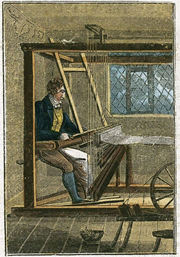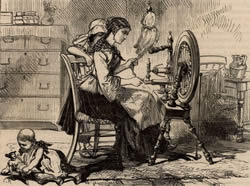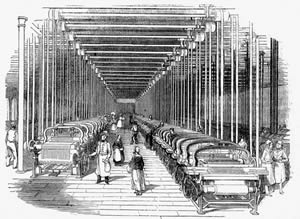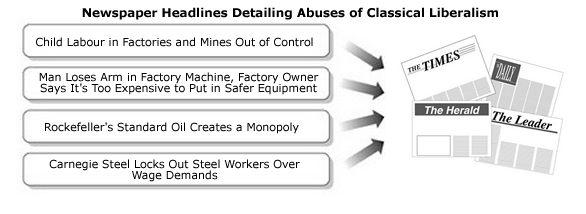Lesson Three: The Effects of Classical Liberalism
| Site: | MoodleHUB.ca 🍁 |
| Course: | Social 30-2 RVS |
| Book: | Lesson Three: The Effects of Classical Liberalism |
| Printed by: | Guest user |
| Date: | Monday, 27 October 2025, 8:12 AM |
Description
1. Introduction
The Effects of Classical Liberalism
Duration - 1 block (80 mins + homework)
There were many positive outcomes of classical liberalism, such as the potential to amass great wealth, risk-taking and innovation. However, although people were free to participate in the economy, many still lived in poverty. As a result, people began to ask:
- Can someone who must work long hours for little pay just to survive truly be considered free?
- Is it fair that children who are poor are exploited by business owners, even though the children may choose to work?
- Are all people really equal when some (for example, women and visible minorities) do not have the same rights, such as the right to vote?
- Should not all individuals have the right to an education?
2
2. Lesson 3.3.1 : Conditions Produced by Classical Liberalism
Classical Liberalism Produces Wealth
Before the Industrial Revolution began in 1750, most people lived in rural communities (the countryside). Manufacturing of products occurred mostly in people's homes. This was called the domestic system. For example, people spun thread on spinning wheels or wove cloth on small looms using their own hands or feet to power these simple textile machines. Entrepreneurs went from home to home to collect the thread and cloth. Spinners and weavers were paid small amounts for their work.
Textile manufacturing had been done this way for hundreds of years. However, the domestic system was very slow and ineffective because neither the quality of the cloth nor the hours these people worked were controlled.
 Weaver
Weaver
 Spinner
Spinner
With the coming of the Industrial Revolution, the production of goods became industrialized. That is, manufacturing began to use first water-powered then steam-powered machines in large factories. This was called the factory system. Textile factories produced large volumes of quality cloth goods in much less time than under the old domestic system.
Manufacturing moved from the rural areas into urban centres (cities). With the use of machines in factories, manufacturing became more efficient and profitable. Those entrepreneurs who had the knowledge and money to build factories and were able to compete successfully in the market earned large amounts of wealth.
Adam Smith's economic values of classical liberalism seemed to be working quite well. Entrepreneurs were making large amounts of wealth for themselves. As long as the government stayed out of the economy, things could not have been better. Indeed, governments tended to stay out of the economy, and few laws interfered with individual rights just as people such as John Stuart Mill had argued.

Textile Factory
3. Lesson 3.3.2 Classical Liberalism Produces Poverty
Immediately before and during the Industrial Revolution, the Agricultural Revolution was also occurring and was providing farmers with improved farming methods that increased food production considerably. However, usually only rich farmers could afford the new farm machinery that was being invented. The smaller, poor farmers could not compete and usually had to sell to the richer farmers. As well, fewer people were needed to farm the land because of the machinery. Therefore, many farmers sold their lands to go find work in the industrial cities.

London Slum
Imagine that your family had owned the same farm for generations, and then your father was forced to sell it and move your family to the city to find work. Your father, mother, younger sisters, and brothers all must work in a factory for your family to survive. The factory smells bad, there is no fresh air, it's filthy, and you see rats. Your mother and father are exhausted from the long hours as are your siblings, but you have no choice. All of you must work for wages that are just enough for your family to survive. You see people die of exhaustion and disease. Education to help you get ahead does not exist for workers. To you, only the factory owners are rich.
This movement of families from small farms to the industrial cities produced a large labour force for the new factories in the cities. For the working class, living and working conditions in the factory cities were deplorable and salaries were small
Newspaper Headlines Detailing the Abuses of Classical Liberalism

Watch this video on the pros and cons of capitalism or classical liberalism and complete the chart attached here as you go.
In order to get a better understanding of the effects of classical liberalism please read pages 116-123 in your textbook, Understandings of Ideologies. You are encouraged to create notes about the material you have read.
After you have completed the assigned pages read the "Child Labourers Speak" and answer questions 1 and 2.
Self-check your answers here.
4. Conclusion
Unfortunately, the strong influence of classical liberalism and individualism during the Industrial Revolution had some very negative consequences. Many industrialists and manufacturers, who embraced the ideas of a free-market economy and laissez-faire capitalism, ran their businesses to earn profits for their own self-interests. They believed in free competition in the marketplace and freedom from government intervention, such as regulations regarding the rights of workers. As a result, their employees often had to work longer and harder than before.
Summary Chart of Conditions during the Industrial Revolution under Classical Liberalism
Entrepreneurial
Class Conditions Working Class Conditions Work Environment · Those that worked were in managerial positions that did not
involve heavy labour ·
Often
took long vacations with family ·
Employed
working class people for very little money to take care of household chores ·
Wealthy -
did not share profits fairly with workers Living
Environment · Able to afford the finest food, clothing, and shelter in the
best parts of cities (where waste and sewage was disposal was taken care of) ·
Able to
afford medical care and education · City slums: Because of low wages, workers could hardly afford
rent; owning a house was out of the question no matter how hard one worked;
landlords would not improve housing because that decreased rent profits ·
Pollution:
Factories dumped their waste directly into environment nearby, which was
where workers lived. ·
Overcrowding:
City infrastructures did not support the numerous workers; clean water,
sewage and waste disposal, garbage collection was unavailable; inexpensive
housing usually nonexistent or affordable, so families lived often within one
room of rundown apartments. (No birth control meant large families; life
spans were short.) ·
Health
care: Doctors and hospitals (poorly skilled) were financially unavailable for
the average worker; illness and workplace accidents took their toll. ·
Education:
Schooling was not publicly funded; education was largely unavailable to
working class. Government Involvement
